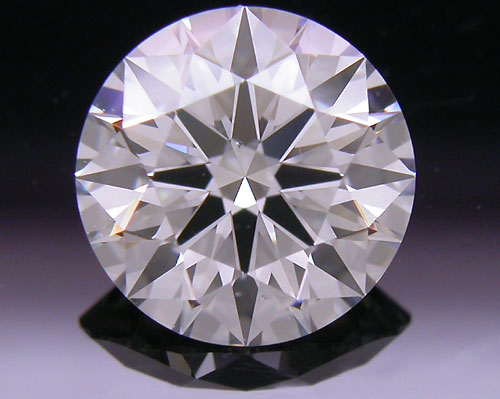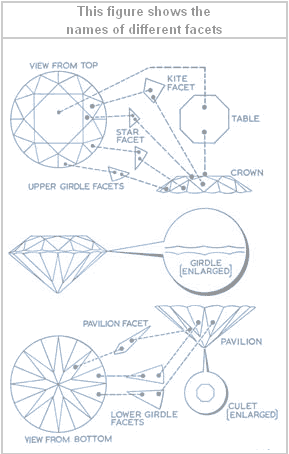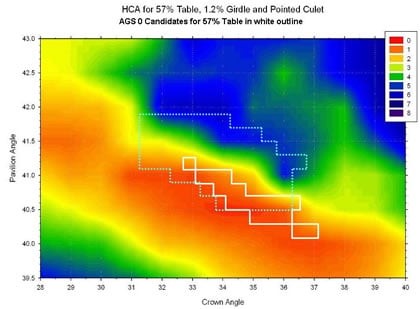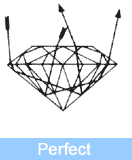We’d like to remind Forumites to please avoid political debate on the Forum.
This is to keep it a safe and useful space for MoneySaving discussions. Threads that are – or become – political in nature may be removed in line with the Forum’s rules. Thank you for your understanding.
📨 Have you signed up to the Forum's new Email Digest yet? Get a selection of trending threads sent straight to your inbox daily, weekly or monthly!
Engagement Rings (merged)
Comments
-
Thanks very much for your advice Debbie, very interesting.
You're right about the quality of the High-Street rings - I was being quoted a colour of around G and clarity of around SI1 or SI2. However, they were not certified, so I guess they could be telling me anything!
A question - If I bought from the high street based on the verbal description, could I get it valued professionally elsewhere. Would I have any right to return if the quality is different to what they quote? Some jewellers offer a no-quibble refund guarantee anyway, but would I have a right to demnd the valuation fee back too? (I'm guessing valuation costs about £75, so it's a lot of money to lose if I just return the ring for a refund.)
Anyway.....for now...I have bought the ring from Geraldonline. 1 carat, 5 diamond ring on 18carat gold band - with certificate! £799.
I have 30 days to return it for a refund. And I WILL be returning it.....!
Although it has a certificate, all the certificate tells me is that it is certified poor quality!
Colour=I, Clarity=SI3
No wonder it is so cheap. And no wonder they wouldn't quote the quality before I bought it!
I think I'd spend more money and get a better quality ring from a high-street jeweller. The only thing putting me off is all the comments about 'never buy a ring from a high-street jeweller' and that 'mark-ups are at least 33%'.....
I'm going to keep the ring over Christmas to give to wifey, so that she knows what I'm getting her, but I will explain that it is not good enough for her, and I'm going to swap it for a better one in early January. I might try Rock Lobster Jewellers as you suggest, or may take a trip to the Jeweller's Quarter in Birmingham - that's assuming I'll find decent quality at a better price there. Any advice?
Cheers,
DonThere are 10 types of people in the world. Those who understand binary, and those who don't!0 -
How about this?
http://stores.ebay.co.uk/DESIGNER-DIAMOND-JEWELLERY_W0QQcolZ4QQdirZ1QQftidZ2QQtZkm
They say you can visit their shop in the jewellery quarter. It looks very tempting. Has anyone dealt with them?Silence is more musical than any song0 -
Hi Don, I would definately go to the jewellery quarter as your next stop. Its an area in Birmingham that is made up of over 40 independent shops - some of which have been there for over 20 years.
I bought my wifes engagment and wedding ring and in comparison to the high street at the time it was 30% cheaper. The particular shop I visit my family has had over ten rings from there ! I'm not endorsing this particular shop as there is so much choice - but maybe if you gave a few of them a phonecall to quote what you want and get an estimate before you go down.
Let us know how you get on0 -
Have you tried hatton gardens in london, they are the main diamond merchants in this country?, i know its a long trek down, but i think they may have online shops. Also, i would haggle with the independants, i got my 1.5 carat vvs2 colour E 3 stone diamond ring with a certificate & insurance valuation & a matching 22 carat gold band for £1500!!. Living in Birmingham area, i believe there are alot of asian jewellers, i would try there as well-worked for me!!. Hope this helps, goodluck
 No one said it was gonna be easy!0
No one said it was gonna be easy!0 -
Hi there, Stumpjumper's to be other half here.
Noticed there where a few threads asking about engagement rings recently, and knowing now till Valentines is the busiest period in the diamond market i thought maybe like the wedding tips thread to add a few notes and pointers to help guide folk through what can be an imtimidating process.
firstly for better and clearer explinations heres a few links on diamond education:
http://www.goodoldgold.com
http://www.whiteflash.com
http://www.cooldiamonds.com
http://www.pricescope.com
the first three links are diamond sellers, but they have good non biased information available on their sites. Good Old and Whiteflash are both USA based, while cool diamonds is UK, but it'll allow you to get a good idea on price on both sides of the atlantic.
Pricescope is an independant diamond buyers help forum, again lots of information available on the site - and was the place that gave me my diamond knowledge, and the confidance to proceed the way i did.
first tip - is to take your time, do a little research so you know more about the 4Cs - Cut, Clarity, Carat and Colour.
tho i tend to say the 6Cs Cut, Clarity, Cut, Colour, Cut, Carat.
i say this as cut is THE most important factor in a diamond - it is this that makes a diamond sparkle - if its poorly cut - then it wont sparkle. But this is one of the easy bits to look at - as it is not a subjective thing... its how it looks to your eyes. yet it is the one that doesnt affect the price - except when looking at brands and 'ideal' cuts. (cut is often confused with shape - Round Brilliant, Princess, Assher, Radient, Pear etc.)
a word of warning tho - your average jewellers - high street or what not - often throws enough light at their rocks to make a peice of coal sparkle! so best way when looking is to request to look at it away from their spotlights - under flouresant tubes, even better, in daylight - this will reveal more about what the diamond is like in the real world than a certificate. its how it looks to your eyes that matter.
anyways i will come back to cut later.
firstly - dont be afraid of online diamond buying - its no worse than buying in the shop, and you are covered by the same comsumer laws as the high street. Yes do your homework to ensure you are buying from a reputable place. Ask questions of the sellers - both in the highstreet, and online.
right moving on - certificates and grading reports.
there are several labs out there which grade labs (tho these reports are not valuation reports) they are an independant experts opinion as to the quality of an unset diamond or gem - against a set scale. grading labs trade on their integraty for honest and accurate gradings and do not sell diamonds. Different labs provide differing levels of information on their reports. some of this is useful to the average consumer, some isnt (but is to the diamond geeks like myself) by this i mean, pretty much all lab grade reports give 4C info. some then go futher to give information about the angles of the diamond.
the Labs your most likely to come across in the UK market are GIA, IGI, BGA, HRD and EGL. (and on the US market AGS too)
Pricescope did a comparison of 3 of those labs here http://grading.pricescope.com/
ok? still with me?
onto the basics.
Colour
A colour grading is given to the most common diamond colouring - yellow. This is normally graded on a scale of D to Z (system started by GIA for clarity as previous conflicting systems where so confusing... some started A, others AAA, or I... so GIA started again - as an aside AGS use their own system of 0-10 0=D 0.5=E 1=F and so on to 10=X)
D is Colourless
Z is Very Yellow.
and this is graded with the diamond upside down against a white background, against a set of master stones.
Colour is a subjective grade... most labs are graded then moderated with a second oppinion. the differences between a D grade and F grade is very small, but the difference between a G grade and I grade is much bigger.
E and F are still in the colourless range
G H I (and sometimes J) are near colourless - with a small hint of yellow against the white background.
K and below are tinted - the yellow is easier to see. and you start moving more into 'fancy colour' diamonds
the reason for the upside down grading is that the colour is hidden more when viewed 'pointy bit down'
colour also affects the price - D is the most expensive as it is a much rarer diamond... yet when set to all but the most colour sensitive will look exactly like a G/H graded diamond, yet has a premium of around 50-60% over the G/H
Tempered with this is the one that gets forgotten... Flouresance. this is what happens when the diamond is exposed to UV light. around 50% of diamonds can be observed to react to UV light.. this is caused when there was traces of Boron when the diamond was formed.
Flouresance can affect the diamond's look and price. both up and down, as flouresance can be a good thing, and it can be a bad thing. the most common reaction under UV is for the diamond to glow blue - tho some glow green, yellow, orange and white
left to right very strong, strong, Medium blue flouresance
Now as you know - sun light contains UV light, with blue flouresance this glow will come through to different extents. what this will do is with a lower colour like I, J, K the blue of the flouresance will cancel out some of the yellow tint of the diamond to make it appear whiter. But a strong flouresance may cause the diamond to appear cloudy or misty. which is why i said before it was important to view your choice under daylight.
in real terms - in the colour grades D-H strong to medium flouresance will knock 1-15% off the price of the diamond, while I and below strong to medium flouresance will ADD upto 4% to the price as it makes these diamonds appear whiter than they are. in all cases faint flouresance doesnt affect the price as it is very difficult to see, so doesnt affect the look of the diamond.
Bottom line with fluorescence:
Don't let fluorescence discourage your purchase. ONLY if it is noticeably visible to the human eye making the stone look chalky should you consider turning down the purchase. When you are purchasing, ASK if there is fluorescence. If there is "very strong" fluorescence ask if you can compare it with another and if you don't like what you see... don't buy.
Clarity
clarity is a mesure of 'inclusions' and their visability under 10x magnification.
an inclusion is anything within the diamond, it can be peices of carbon to other mineral or gem material.
it is graded again from the underside with backlighting against a dark background
this is measure by the GIA lab as ranging from IF, VVS1(and VVS2) VS1 (and 2) SI1 (2 and sometimes 3 depending on the lab) I1 I2 I3
these mean
IF - Internally Flawless
VVS - Very Very Slightly included
VS - Very Slightly included
SI - Slightly Included
I - Included (some labs - EGL or IGI from memory of visiting Earnest Jones grade I as P instead)
again IF attracts a BIG premium over the other grades, yet to the naked eye most folk wont beable to tell the difference between IF and VS or even SI when set.
Now inclusions can be manythings as i said, and they can be anywhere within the diamond. for examples Cooldiamonds.com have a good little selection of magnified images in their help guide. for example a VS grade could be gained by a single lump of coal in the middle of the diamond under the 'table', easily seen, or it could be many tiny spots around the girdle of the diamond, so tiny they can not be seen without magnification... both have the same grade - but to me one is the better buy.
now inclusions are not bad things in themselves... they are the stones 'birth marks' - unique to each diamond, and if you know where they are, you can check its your diamond if you've had to take the ring to be repaired or cleaned.
also important to note that IF does not mean it is totally flawless - just that nothing can been see under 10x magnification, tho bump it up to 64x and you'll quite possibly see things within it. and over time when worn, a diamond will get knocked and bashed which can damage a stone, and that IF grade is soon lost so again a big premium for its rarity of being IF soon lost on the finger and for something that you wont beable to tell visually between it and a much lower grade.
so again a big premium for its rarity of being IF soon lost on the finger and for something that you wont beable to tell visually between it and a much lower grade.
SI1 is really where things can start to become easier to see without magnification. SI3 is a grade used by some labs to bridge a mental gap between SI2 and I1. as there is a big price drop between SI and I. and personally i really would steer clear of I2 and 3 graded diamonds. I1 while can have an easily visible inclusion it can, depending on the position be hidden by the setting, and doenst always affect the brilliance of the diamond.
I2 and I3 CAN effect the brilliance and the inclusion may also affect the integraty of the stone - in as much as the size of the inclusion may lead to a very weak stone that may break if banged
VS1-I1 can be a great way of maximising your budget for getting plenty of diamond for the pound, but just be aware of what to look for, have a look though the sites above for pictures of diamonds, look carefully at your intended purchase. if buying online talk to someone and get their oppinion about weither the diamond is 'eye clean' or not.
i will come to Carat and Cut in the next post.2009 wins: Signed Saxon CD, Solar Torch, Drumsticks, Priest Feast Tix, Watch, Hammerfest tix :beer:0 -
Ok,
Now onto the remaining Cs – Carat and Cut
Carat
The easiest of the Cs to understand. This is simple the diamonds weight on a set of scales. With 1ct (carat) equalling 0.2gramms. The weight can be expressed in several ways, but all mean the same. 1ct = 100points. So 25 points is 0.25ct or 1/4ct. and I believe the most accurate we can weight to is to 3 decimal places of a carat – 1.001ct
Ok, getting more into it. From a legal stand point (tho I am no lawyer) I believe the situation stands at this – if a diamond is advertised at a particular weight it needs to be within 0.5 of the last decimal point quoted… hard to describe easy to show in numbers.
For example – a diamond advertised as being 1ct means 1.000 so legally needs to weight between 0.95 and 1.05 while if it was advertised with a certificate which stated it was 1.000 then its between 0.9995 and 1.0005 and moving down to say 1/2ct then between 0.45 and 0.55 but if advertised as 0.50 or 50 points then its between 0.495 and 0.505.
Now you may wonder why I make pains at this bit, but in diamond pricing there are magic numbers. A diamonds price is determinded against a price per carat in the trade – sometimes called the rap report. This lists a price per carat for different weights of diamonds according to its colour and clarity. These prices are grouped in sets. 0.1-.49, 0.5-0.74, 0.75-0.89, 0.9-0.99, 1.0-1.49, 1.5-1.99, 2.0-2.49 and so on in 1/2ct groups so the magic numbers in carats being 0.5, 0.75, 0.9, 1, 1.5, 2 and so on.
With a price per carat rise of between 7 and 12% at these points
Taking an example of a G SI1 – in the 0.9-0.99 bracket being $5000 per carat
So for a G SI1 diamond weighing 0.99ct being 0.99 x 5000 = $4950
Now the next group of 1-1.5ct bracket the price per carat rises to $5600
So now our 1.001ct G SI1 diamond – 1.001 x 5600 = $5605.60
And it is for this reason that 99% of the diamonds are cut for weight retention, not for looks, simply because the cutter and then the dealer is able to sell for more money if the diamond breaks that magic number barrier. Even though the visual difference between 0.99 and 1.001 is zero you will pay $655.60 extra for the stone that weights 0.002cts more. Not only that – the pursuit of weight does not correspond to greater visual size, this is where the cut comes in.
Cut
Ok this is where it can get geekie… and taken to a high plane of extreme pedantitry and I will try and avoid getting too deep.
Simply put in this context I am talking about Round Brilliant diamond
Other shapes are available, all with their own cut criteria’s, and there are people more knowledgeable on them than me, again see Good old Gold (above), http://www.gemappraisers.com and Pricescope (above)
Here is a simple explanation from Debeers http://www.adiamondisforever.com/buy/4cs_flash.html
Ok, so, still with me?
Right, Cut is the only human influence on the look of a diamond, and in the end effects its final weight from the initial rough diamond. In the process of cutting upto 60% of the rough diamond can be lost trying to extract the most expensive/profit making yield of cut diamond.
A round brilliant diamond is made up of 57 facets (sometimes 58 if the culet is included)
To borrow Whiteflash’s image
And it is the proportions of these parts which the combined result is that the diamond sparkles and explodes with fire
or remains as dull as dishwater.
And this is down to the skill of the cutter and the time he has to cut the diamond. Cutting for looks takes time… and results in a smaller diamond.
These are often called ‘ideal’ cut diamonds, but a lot of liberty is taken with this word that it can be hard to cut through the chaff to the good stuff… with only around 1% of diamonds on the market matching upto the strict criteria of cut experts.
It is also difficult in this country to find any info about cut as it is only the American Gemological Society (AGS) which issue cut information on their certificates in a form which allows a detailed look at the proportions by giving the angles of the crown and the pavilion, as well as the table width and total depth and the physical size – as in the diameter and depth in mm of a diamond. GIA are changing their certificates to also give this information to recognise the growing requests for this information in the USA where cut info is more available.
Most certificates on the market simply detail depth and table size and size in mm
The general used term of an ideal cut diamonds means that the proportions of a diamond are like this image
An Australian chap called Garry Holloway has through research prepared a cut adviser with which you can imput the cut info to get a score on its performance in terms of light return, fire and scintilation
I know that looks complicated but there is a good explanation here http://www.pricescope.com/cutadviser.asp
Now when it comes to diamond cutting each facet is simple a two way mirror – it can let light in and it can reflect or refract that light. It is this which causes it to sparkle. A diamond cut too deep or too shallow allows like to ‘leak’ out of it. Ideally a depth of 59-63% of its width is ideal, but with the majority of a diamond weight found below the girdle – many cutters go for profit and cut their diamond deeper to gain weight. This means any light entering through the crown escapes through the pavilion


Now to help there are little devices you can buy if you want to look in detail at the cut of stones in the store, that if your spending your heard earned and want to spend wisely it can help. Its called and Ideal Scope – from the same chap the drew up the cut adviser chart.
http://www.idealscope.com
I’m not saying its imperative that you buy one, but if you want to checkout the cut quality of stones instore then it’ll help. And can also help you look a bit more pro when you go to the store so you may get better treatment… tho on the couple of occasions I’ve ended up giving diamond advise to the sales guys behind the counter – since I turned up to look with a loupe and a ideal scope.
But this is the getting onto the geekly level. And I don’t know how many of you reading this want to get in on that level. But it’s a little past time of mine and I enjoy the more detailed workings of the intricacies of the skill of a good cutter.
To some the top of the pile in terms of cut quality are those who cut ‘super’ ideal diamonds known as Hearts and Arrows. Now again like Ideal diamonds – H&A is a much abused term in diamonds and we are down to 1% of the 1% of the ideal cut diamonds on the market. And that in its self not a guarantee of a great diamond
At present (tho the labs are changing their criterior but that is beyond the scope of my knowledge at present and beyond the need for this post) AGS is the only lab that grades cut – AGS 0 being the top ‘ideal.’ GIA released their version earlier this year… but I believe was a broader grading system of 0-5 where as AGS is a tighter 0-10 grading
Getting to Hearts and Arrow level perfection in diamond cutting is like unplugging from the Matrix – and beyond the scope of the majority in the diamond trade – often dismissed as a fad… it has its accolites and its detractors. And rightly so. personally I love H&A others don’t like the look.
What to I mean by H&A perfection…
Tune in next post. 2009 wins: Signed Saxon CD, Solar Torch, Drumsticks, Priest Feast Tix, Watch, Hammerfest tix :beer:0
2009 wins: Signed Saxon CD, Solar Torch, Drumsticks, Priest Feast Tix, Watch, Hammerfest tix :beer:0 -
Welcome back
Right onto H&A diamonds
For those of you not wishing to into the nitty gritty of this, skip this post… next up will be something easier to handle
k…
What do I mean by Hearts and Arrows. Well, there are some cutters who will go the extra mile to make an AGS "0" exhibit natural phenomena which can be viewed through something called a fantasy scope or Hearts & Arrows viewer. The phenomena is perfectly formed arrows when viewing a diamond through it's crown in the fantasy scope and perfectly formed hearts when viewing the stone through it's pavilion. Here's what a fantasy scope (or hearts and arrows viewer) looks like.
All it is is a way of cutting out all light reaching the diamond except from above, a coloured tube and a magnifying glass.
When a diamond is viewed through this viewer this is what the H&A diamond looks like
The difference between an H&A and the average cut quality of the high street can be seen in this image
I will leave it upto you which look you prefer – there is no wrong answer to that one – as it is you who does the choosing and deciding is it worth paying for.
H&A was originally found in Japan when a sales man was trying to prove to a client how much better his diamonds where than the average diamond on the market. And it is from this research to prove cut quality that the phenomena were found.
Ideal H&A is tied up with the ideal cut – a badly proportioned stone can still exhibit H&A, yet be very dull, and you can have a very sparkly diamond that doesn’t show any H&A patterning, but put find a Ideal cut H&A then to me your onto a winner. To achieve this patterning each facet must be perfectly cut and polished and aligned. This also results in the diamond taking much MUCH longer to cut (like weeks), and results in around an extra 20% loss in weight – hence why they are so rare on the market. As such because only a few companies cut to this level – they have established brands – and as such attract a premium over the equivalent weight of diamond for that brand – most famous of the H&A is the 8* or Eightstar. Others of the main stream names are Hearts on Fire, Aglaia® diamonds and Lazare Kaplan Ideal®. These can be found in some high street stores other stores have their own brands which attract premiums.
Online ideal and H&A cutters Whiteflash, Infinity, Superbcert and a couple more I forget.
Those online don’t charge as high a premium as the instore ones, and very competitive on price.
Some also have an almost range – (trying to stay neutral on this so bear with me) Whiteflash have for example their expert selection, others have their own version. Where they sell those that didn’t quite make the grade for their brand quality, or they are diamonds which they have bought from the main trade dealers.
That is something I will go into next post.2009 wins: Signed Saxon CD, Solar Torch, Drumsticks, Priest Feast Tix, Watch, Hammerfest tix :beer:0 -
heya, loooks like you got some time on your hands here!!
Gotta download all this info now to safekeep it for later when i have time to study it all!!
Thanks for the thread, I am still looking for my 'Perfect' engagement ring....talk about research!!do you believe in Fairies?
It is that what you do, good or bad,
will come back to you three times as strong!0 -
cheers,
cant believe i took me most of friday to type out!!! lol
will get back to it in the next day or so when i have time
dont worry, the perfect ring is out there for you - tho you can have fun lookingaround.
some of the stuff above is going to be above and beyond much of what you'll find in a jewellers, but should give you more info than the average high street jewellers shop assistant in the chains whoes really only trained in their credit facilities...2009 wins: Signed Saxon CD, Solar Torch, Drumsticks, Priest Feast Tix, Watch, Hammerfest tix :beer:0 -
I can recommend pricescope too - did my reseach there and bought my certified diamond and had it set by one of their suggested dealers. Had it valued over here for more than 3 times what we paid for it in dollars.0
This discussion has been closed.
Confirm your email address to Create Threads and Reply

Categories
- All Categories
- 353K Banking & Borrowing
- 254K Reduce Debt & Boost Income
- 454.8K Spending & Discounts
- 246.1K Work, Benefits & Business
- 602.2K Mortgages, Homes & Bills
- 177.8K Life & Family
- 260K Travel & Transport
- 1.5M Hobbies & Leisure
- 16K Discuss & Feedback
- 37.7K Read-Only Boards




